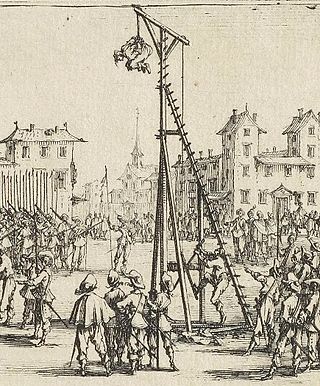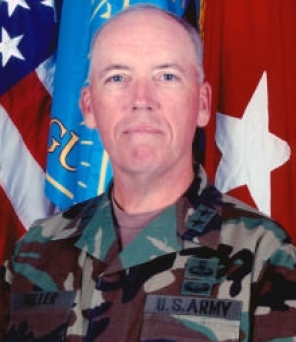Related Research Articles

The strappado, also known as corda, is a form of torture in which the victim's hands are tied behind their back and the victim is suspended by a rope attached to the wrists, typically resulting in dislocated shoulders. Weights may be added to the body to intensify the effect and increase the pain. This kind of torture would generally not last more than an hour without rest, as it would otherwise likely result in death.
Hoeryong concentration camp was a death camp in North Korea that was reported to have been closed in 2012. The official name was KwallisoNo. 22. The camp was a maximum security area, completely isolated from the outside world.
About six months after the United States invasion of Iraq of 2003, rumors of Iraq prison abuse scandals started to emerge.

Waterboarding is a form of torture in which water is poured over a cloth covering the face and breathing passages of an immobilized captive, causing the person to experience the sensation of drowning. In the most common method of waterboarding, the captive's face is covered with cloth or some other thin material and immobilized on their back at an incline of 10 to 20 degrees. Torturers pour water onto the face over the breathing passages, causing an almost immediate gag reflex and creating a drowning sensation for the captive. Normally, water is poured intermittently to prevent death; however, if the water is poured uninterruptedly it will lead to death by asphyxia. Waterboarding can cause extreme pain, damage to lungs, brain damage from oxygen deprivation, other physical injuries including broken bones due to struggling against restraints, and lasting psychological damage. Adverse physical effects can last for months, and psychological effects for years. The term "water board torture" appeared in press reports as early as 1976.

Geoffrey D. Miller is a retired United States Army major general who commanded the US detention facilities at Guantanamo Bay, Cuba, and Iraq. Detention facilities in Iraq under his command included Abu Ghraib prison, Camp Cropper, and Camp Bucca. He is noted for having trained soldiers in using torture, or "enhanced interrogation techniques" in US euphemism, and for carrying out the "First Special Interrogation Plan," signed by the Secretary of Defense, against a Guantanamo detainee.
Hooding is the placing of a hood over the entire head of a prisoner. Hooding is widely considered to be a form of torture; one legal scholar considers the hooding of prisoners to be a violation of international law, specifically the Third and Fourth Geneva Conventions, which demand that persons under custody or physical control of enemy forces be treated humanely. Hooding can be dangerous to a prisoner's health and safety. It is considered to be an act of torture when its primary purpose is sensory deprivation during interrogation; it causes "disorientation, isolation, and dread." According to the International Committee of the Red Cross, hooding is used to prevent a person from seeing, to disorient them, to make them anxious, to preserve their torturer's anonymity, and to prevent the person from breathing freely.
Torture, the infliction of severe physical or psychological pain upon an individual to extract information or a confession, or as an illicit extrajudicial punishment, is prohibited by international law and is illegal in most countries. However, it is still used by many governments. The subject of this article is the use of torture since the adoption of the 1948 Universal Declaration of Human Rights (UDHR), which prohibited it.
Water torture encompasses a variety of techniques using water to inflict physical or psychological harm on a victim as a form of torture or execution.
The women in prison film is a subgenre of exploitation film that began in the early 20th century and continues to the present day.

Penal labour is a term for various kinds of forced labour that prisoners are required to perform, typically manual labour. The work may be light or hard, depending on the context. Forms of sentence involving penal labour have included involuntary servitude, penal servitude, and imprisonment with hard labour. The term may refer to several related scenarios: labour as a form of punishment, the prison system used as a means to secure labour, and labour as providing occupation for convicts. These scenarios can be applied to those imprisoned for political, religious, war, or other reasons as well as to criminal convicts.

Foot whipping, falanga/falaka or bastinado is a method of inflicting pain and humiliation by administering a beating on the soles of a person's bare feet. Unlike most types of flogging, it is meant more to be painful than to cause actual injury to the victim. Blows are generally delivered with a light rod, knotted cord, or lash.
The Guantanamo Bay detention camp is a United States military prison within the Guantanamo Bay Naval Base, also referred to as Gitmo, on the coast of Guantánamo Bay in Cuba. As of April 2023, of the 779 people detained there since January 2002 when the military prison first opened after the September 11 attacks, 740 had been transferred elsewhere, 30 remained there, and nine had died while in custody.

Gates v. Collier, 501 F.2d 1291, was a landmark decision of the Fifth Circuit Court of Appeals that brought an end to the trusty system as well as flagrant inmate abuse at Mississippi State Penitentiary, also known as Parchman Farm, in Sunflower County, Mississippi. It was the first case in a body of law developed in the Fifth Circuit Court of Appeals holding that a variety of forms of corporal punishment against prisoners constituted cruel and unusual punishment and a violation of Eighth Amendment rights. This case was also the first broad-scale intervention by a court in the supervision of prison practices.
There are cases, both documented and alleged, that involve the usage of torture by members of the United States government, military, law enforcement agencies, intelligence agencies, health care services, and other public organizations both in and out of the country.
"Enhanced interrogation techniques" or "enhanced interrogation" was a program of systematic torture of detainees by the Central Intelligence Agency (CIA), the Defense Intelligence Agency (DIA) and various components of the U.S. Armed Forces at remote sites around the world—including Bagram, Guantanamo Bay, Abu Ghraib, and Bucharest—authorized by officials of the George W. Bush administration. Methods used included beating, binding in contorted stress positions, hooding, subjection to deafening noise, sleep disruption, sleep deprivation to the point of hallucination, deprivation of food, drink, and medical care for wounds, as well as waterboarding, walling, sexual humiliation, rape, sexual assault, subjection to extreme heat or extreme cold, and confinement in small coffin-like boxes. A Guantanamo inmate's drawings of some of these tortures, to which he himself was subjected, were published in The New York Times. Some of these techniques fall under the category known as "white room torture". Several detainees endured medically unnecessary "rectal rehydration", "rectal fluid resuscitation", and "rectal feeding". In addition to brutalizing detainees, there were threats to their families such as threats to harm children, and threats to sexually abuse or to cut the throat of detainees' mothers.
Article 3 of the European Convention on Human Rights prohibits torture, and "inhuman or degrading treatment or punishment".
Article 3 – Prohibition of torture
No one shall be subjected to torture or to inhuman or degrading treatment or punishment.
The widespread and systematic use of torture in Turkey goes back to the Ottoman Empire. After the foundation of the Republic of Turkey, torture of civilians by the Turkish Armed Forces was widespread during the Dersim rebellion. The Sansaryan Han police headquarters and Harbiye Military Prison in Istanbul became known for torture in the 1940s. Amnesty International (AI) first documented Turkish torture after the 1971 Turkish coup d'état and has continued to issue critical reports, particularly after the outbreak of the Kurdish-Turkish conflict in the 1980s. The Committee for the Prevention of Torture has issued critical reports on the extent of torture in Turkey since the 1990s. The Stockholm Center for Freedom published a report entitled Mass Torture and Ill-Treatment in Turkey in June 2017. The Human Rights Foundation of Turkey estimates there are around one million victims of torture in Turkey.
Human rights in Tibet are a contentious issue. Reported abuses of human rights in Tibet include restricted freedom of religion, belief, and association; arbitrary arrest; maltreatment in custody, including torture; and forced abortion and sterilization. The status of religion, mainly as it relates to figures who are both religious and political, such as the exile of the 14th Dalai Lama, is a regular object of criticism. Additionally, freedom of the press in China is absent, with Tibet's media tightly controlled by the Chinese leadership, making it difficult to accurately determine the scope of human rights abuses.
Chongori concentration camp is a reeducation camp in North Korea. The official name of the camp is Kyo-hwa-so No. 12.
Prisons in North Korea have conditions that are unsanitary, life-threatening and are comparable to historical concentration camps. A significant number of inmates have died each year, since they are subject to torture and inhumane treatment. Public and secret executions of inmates, even children, especially in cases of attempted escape, are commonplace. Infanticides also often occur. The mortality rate is exceptionally high, because many prisoners die of starvation, illnesses, work accidents, or torture.
References
- ↑ Sheldon, Randall G. "Slavery in the Third Millennium, Part II – Prisons and Convict Leasing Help Perpetuate Slavery". The Black Commentator, Issue 142, 16 June 2005. Accessed 10 June 2009.
- ↑ Reed, John D. Billings ; illustrated by Charles W. (1981). Hardtack and coffee, or, The unwritten story of Army life. [Alexandria, Va.]: Time-Life Bks. p. 146. ISBN 0-8094-4210-8.
{{cite book}}: CS1 maint: multiple names: authors list (link) - ↑ Moe, Tom. "Pure Torture" Archived 22 December 2005 at the Wayback Machine (PDF version). Notre Dame Magazine, Winter 1995–96. Via the Internet Archive. Accessed 10 June 2009.
- ↑ Torture in Detention Centres and Labour Camps Archived 27 March 2006 at the Wayback Machine . "China in Tibet – Striking Hard Against Human Rights", 1997 Annual Report, Human Rights Violations In Tibet. Tibetan Centre For Human Rights And Democracy, 4 February 1998. Accessed 10 June 2009.
- ↑ Starr, Barbara. "U.S. segregates violent Iraqi prisoners in crates". CNN, 7 August 2008. Accessed 10 June 2009.